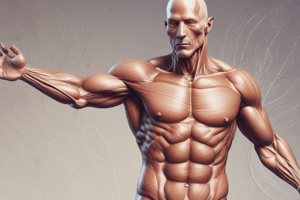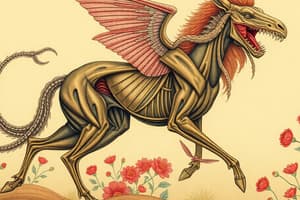Podcast
Questions and Answers
What type of movement is characterized by directed movement from one place to another?
What type of movement is characterized by directed movement from one place to another?
- Involuntary movements
- Passive movements
- Voluntary movements
- Locomotion (correct)
Which system provides support, protection, and facilitates movement in the body?
Which system provides support, protection, and facilitates movement in the body?
- Circulatory system
- Digestive system
- Respiratory system
- Skeletal system (correct)
What is the study of muscle contraction and force generation known as in biology?
What is the study of muscle contraction and force generation known as in biology?
- Biotechnology
- Genetics
- Cell biology
- Muscle physiology (correct)
Which system is responsible for coordinating and controlling movement in the body?
Which system is responsible for coordinating and controlling movement in the body?
Which type of movement does not involve muscle contractions?
Which type of movement does not involve muscle contractions?
What does biomechanics primarily study in living organisms?
What does biomechanics primarily study in living organisms?
What is the primary function of muscles in the body?
What is the primary function of muscles in the body?
Which type of muscle contraction involves a constant muscle length and increasing tension?
Which type of muscle contraction involves a constant muscle length and increasing tension?
What is the directed movement of an organism from one place to another known as?
What is the directed movement of an organism from one place to another known as?
Which system plays a crucial role in controlling muscle movements through sensory feedback?
Which system plays a crucial role in controlling muscle movements through sensory feedback?
During which type of muscle contraction does the muscle length decrease while maintaining a constant tension?
During which type of muscle contraction does the muscle length decrease while maintaining a constant tension?
Which aspect is involved in the intricate mechanisms underlying various forms of movements in living organisms?
Which aspect is involved in the intricate mechanisms underlying various forms of movements in living organisms?
Study Notes
Overview of Biology, Movement, and Locomotion
Biology encompasses diverse aspects of life, including movement and locomotion. Movement refers to any change in position, whether voluntary or involuntary, and is essential for an organism's survival and function. Locomotion, specifically, is the directed movement of an organism from one place to another. This involves complex interactions among sensory systems, motor outputs, muscle contractions, and interactions with the environment.
In this article, we will delve into the subtopics of muscle contractions, types of movement, the skeletal system, nervous system control, and biomechanics. By exploring these areas, we aim to gain insights into the intricate mechanisms underlying the spectacular array of movements observed in living organisms.
Muscle Contractions
Muscles are responsible for generating force and causing movement by contracting. The contraction occurs when actin and myosin filaments slide past each other, facilitated by the binding and release of ATP. There are three primary types of muscle contractions:
- Isometric: Muscle length remains constant, and tension increases.
- Isotonic: Muscle length decreases while maintaining a constant tension.
- Dynamic: Muscle length decreases while tension increases.
These contractions enable various forms of locomotion, such as walking, running, swimming, and flying.
Types of Movement
Movement can be classified into several types based on their characteristics and functions:
- Locomotion: Directed movement from one place to another.
- Involuntary movements: Unintentional movements, such as peristalsis and heart contractions.
- Voluntary movements: Intentional movements, such as walking, running, and flying.
- Passive movements: Movement without muscle contractions, such as gravity-driven movements.
Each type of movement serves specific purposes, such as avoiding predators, seeking food, or performing vital functions like breathing and digestion.
Skeletal System
The skeletal system provides support, protection, and facilitates movement. It is composed of bones, joints, and ligaments. Bones provide the foundation for muscle attachments, while joints allow for movement and stability. Ligaments connect bones at joints, providing support and limiting excessive movement.
The skeletal system is crucial for the proper functioning of the musculoskeletal system, which is responsible for locomotion.
Nervous System Control
The nervous system is responsible for coordinating and controlling movement. It receives sensory information from the environment and the body's internal state, processes this information, and generates appropriate motor responses. The nervous system can be divided into the central nervous system (brain and spinal cord) and the peripheral nervous system (nerves leading to and from the CNS).
The nervous system's control is essential for proper muscle contractions and coordination during locomotion.
Biomechanics
Biomechanics is the study of the mechanical aspects of living organisms, particularly the mechanical principles underlying movement and locomotion. It encompasses areas such as:
- Muscle physiology: The study of muscle contraction and force generation.
- Bone and joint mechanics: The study of how bones and joints function mechanically.
- Gait analysis: The study of an organism's walking or running patterns.
- Kinematics: The study of the motion of body parts during movement.
- Kinetics: The study of the forces acting on the body during movement.
Biomechanics helps us understand the physical principles that govern movement and locomotion, providing insights into optimal movement patterns and energy efficiency.
In summary, understanding the subtopics of muscle contractions, types of movement, the skeletal system, nervous system control, and biomechanics is crucial for grasping the complexity and intricacy of biology, movement, and locomotion. By exploring these areas, we can gain a deeper appreciation for the diverse and fascinating world of biological movement.
Studying That Suits You
Use AI to generate personalized quizzes and flashcards to suit your learning preferences.
Description
Test your knowledge on muscle contractions, types of movement, the skeletal system, nervous system control, and biomechanics in the context of biology, movement, and locomotion. Explore the intricate mechanisms underlying diverse movements observed in living organisms.




